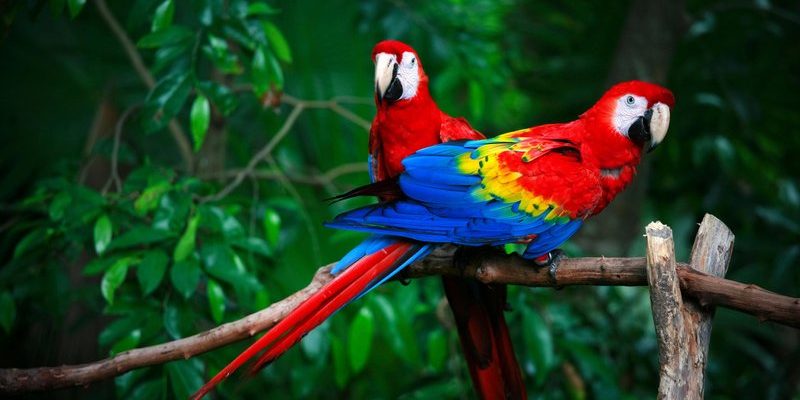
So, what makes these birds so special? Well, beyond their bright plumage and engaging antics, parrot species possess unique characteristics that set them apart from other birds. From their incredible vocal abilities to their complex social structures, there’s a lot to unpack. So grab a comfy seat and let’s dive into the colorful world of parrots!
1. Parrots Are Known for Their Talking Ability
You might be wondering why parrots are famous for talking. Here’s the thing: they have a remarkable ability to mimic sounds, which includes human speech. This talent comes from their highly developed vocal organs. Parrots have a syrinx, located at the base of their trachea, that allows them to produce a wide range of sounds. Imagine being able to sing your favorite song or copy a friend’s laugh—parrots can do just that!
Different species vary in their talking abilities. For instance, the African Grey Parrot is renowned for being one of the best mimics. They can learn hundreds of words and even use them in context. If you’ve ever heard one of these birds speak, it’s truly impressive. It’s like having a little feathered friend who can join in on your conversations!
2. There Are Over 400 Species of Parrots
Parrots come in many shapes, sizes, and colors. Did you know there are over 400 species of parrots globally? From the tiny budgerigar, also known as budgie, to the majestic macaws, each species has its own unique traits and habitats. Some are native to tropical rainforests, while others can be found in savannas or scrublands.
Each species has adapted to its environment in fascinating ways. For example, the Kakapo, a flightless parrot from New Zealand, has a distinct green color that helps it blend into the forest floor. Not all parrots are created equal, and that’s what makes them so intriguing. You could spend hours learning about the different types, their behaviors, and their habitats!
3. Parrots Are Highly Intelligent
Honestly, when we talk about intelligence in the animal world, parrots deserve a gold star. They have the ability to solve problems, use tools, and even understand concepts like cause and effect. Research has shown that some parrots can perform tasks similar to those done by young children. It’s like having a feathered friend who’s not just cute but smart, too!
One study even found that African Grey Parrots could understand the concept of zero. Imagine trying to explain that to your pet! Their intelligence makes them fascinating companions, but it also means they need plenty of mental stimulation. Bored parrots can develop behavioral issues, so engaging them with toys and puzzles is crucial.
4. Parrots Have Long Lifespans
Are you ready for a commitment? Parrots can live a long time—some species can live for over 50 years! For instance, macaws and Amazons can often outlive their owners. This means owning a parrot is a long-term commitment. If you’re considering bringing one into your home, you’ll want to be prepared for a lifelong friendship.
Furthermore, the lifespan of a parrot can be influenced by its care. A well-fed, well-cared-for parrot will thrive, while one that isn’t properly taken care of might not live as long. So, if you’re ready for the journey, you’ll need to ensure you can meet their needs for a lifetime!
5. Parrots Have Unique Social Structures
Parrots are social creatures, often found in flocks in the wild. Their social structures are quite complex, with strong bonds formed between mates and among flock members. They communicate with one another through vocalizations, body language, and even playful behaviors. This makes them highly interactive animals that thrive on socialization.
In captivity, parrots need social interaction to keep them happy and healthy. This interaction can come from humans and other pets. It’s important to spend time with them daily. Without proper socialization, parrots may become lonely or bored, leading to behavioral issues. Think of them like that friend who always needs someone to hang out with; they just prefer feathered company!
6. Their Diet Is Diverse
You might be thinking that all parrots eat seeds, but their diet is much more varied. In the wild, parrots consume a mix of seeds, fruits, nuts, and even flowers. Their beaks are specially designed to crack open hard shells, allowing them to access a wide range of food sources.
In captivity, it’s essential to provide a well-balanced diet that replicates what they would eat in the wild. This includes fresh fruits and vegetables, high-quality pellets, and occasional seeds. A diet lacking in variety can lead to health problems. So if you’re a parrot parent, keep an eye on their meals!
7. They Have Amazing Coloration
Parrots are known for their stunning colors, which can range from vibrant greens and blues to bright yellows and reds. These colors help them blend in with their natural habitats, making it easier to hide from predators. Plus, many species display colorful plumage during mating rituals to attract partners.
It’s not just about aesthetics, either. The colors can play a role in communication among parrots. For instance, a parrot raising its wings might show off its colorful feathers to signal excitement or aggression. It’s intriguing how their beautiful appearance serves multiple purposes in their behavior and survival.
8. Conservation Status Varies by Species
While some parrot species are thriving, others are struggling to survive. Habitat loss, illegal trapping, and climate change threaten many parrot species worldwide. For instance, the Spix’s Macaw was declared extinct in the wild in the early 2000s due to habitat destruction and poaching. Conservation efforts are ongoing to save remaining populations and restore habitats.
If you’re considering adopting a parrot, be sure to research species that are ethically sourced and not endangered. Supporting conservation initiatives is crucial if we want these incredible birds to continue existing for future generations. It’s like being part of a larger mission to keep our planet diverse.
9. They Form Lifelong Bonds
When it comes to relationships, parrots are serious. Many species mate for life, forming strong, lasting bonds with their partners. These bonds are crucial not just for reproduction but also for social structure. If one partner is lost, the other can suffer from grief and depression, showing just how connected they can be.
In a home setting, establishing a bond with your parrot takes time and patience. They need to learn to trust you and feel secure in their environment. It’s rewarding to build that bond—it’s like forming a friendship that deepens over the years.
10. Parrots Are More Than Pets
Finally, let’s touch on the idea that parrots are not just pets; they can be family members. Their playful nature, intelligence, and ability to bond create unique companionship experiences. Owning a parrot isn’t just about having a bird in a cage; it’s about integrating them into your daily life.
If you’re thinking about getting a parrot, be prepared for a relationship that requires both time and effort. You’ll be rewarded with countless memories, laughter, and love. Remember, they can understand and respond to your emotions, making them sensitive companions who enrich our lives.
As we wrap up our exploration of parrots, I hope you’ve found these facts intriguing. They’re beautiful creatures with complex lives and personalities, deserving of our respect and care. Whether you’re already a parrot lover or just getting started, there’s so much to learn and appreciate about these remarkable birds.

